5 Types Of DOVES In Colorado (ID Guide With Photos)
Did you recently come across a dove in the state of Colorado, and want to know what species it was?
Identifying doves in the Centennial State is not as easy as it might seem, since there are several dove species in Colorado (as well as closely related pigeon species).
To help you identify the bird you saw, we’ll cover the most common doves of Colorado in this article.
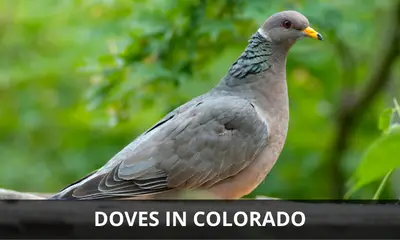
What are the types of doves in Colorado?
The 5 types of doves found in Colorado are:
- Mourning Dove
- Eurasian Collared-Dove
- Rock Pigeon
- Band-tailed Pigeon
- White-winged Dove (rare)
While several of these doves are year round residents of Colorado, others are summer visitors during the breeding season.
Now let’s dive into the details, and take a closer look at each of these doves:
Mourning Dove
Scientific name: Zenaida macroura
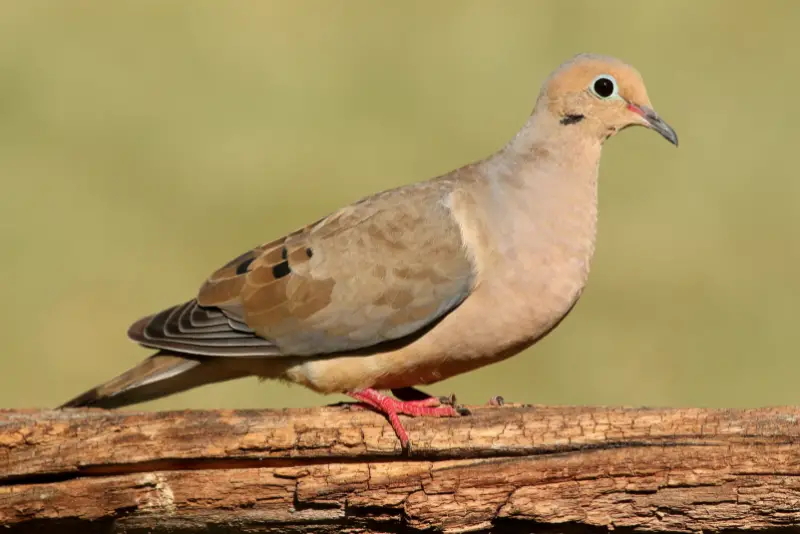
The Mourning Dove is one of the most common birds in Colorado, especially around farms and suburban areas.
This bird is almost entirely grayish-brown with a pale underside. The wings and the tail are pointed, and there is a small black dot on the side of the face.
When viewed up close, a grayish blue eyering as well as pink legs and toes are great distinguishing features of the Mourning Dove.
This is the most common dove found in Colorado
It is a common breeding bird throughout Colorado, and can be seen year-round. During the winter it also frequents open woodland, but avoids large forests.
These birds are often seen perched on telephone wires, or walking around on the ground while foraging for seeds.
You can readily attract these birds to your yard by scattering millet, safflower seeds, Nyjer seeds, and cracked corn on the ground.
But if you do, make sure there are no bushes or shrubs too close to the feeding area, as cats like to use cover to stalk and pounce on these birds while they are feeding on the ground.
Eurasian Collared-Dove
Scientific name: Streptopelia decaocto

The Eurasian Collared-Dove was originally not a native bird of North America.
But after it was accidentally introduced into the Bahamas in the 1970s, the Eurasian Collared-Dove colonized Florida in the 1980s, and then continued its spread throughout most of North America.
You can tell this bird apart from Mourning Doves by its black collar on the neck, as well as the white patches on the tail, which are most prominent when it is flushed from the ground.
The Eurasian Collared-Dove is an invasive species in Colorado
This dove is a common breeding bird in urban habitats of Colorado, where it is often found in the same areas as Mourning Doves.
And while they aren’t migratory, Eurasian Collared-Doves are highly dispersive after the breeding season, and as a result show up in areas where they normally don’t breed.
You can readily attract these birds to your backyard by offering bird seeds scattered on the ground.
Rock Pigeon
Scientific name: Columba livia
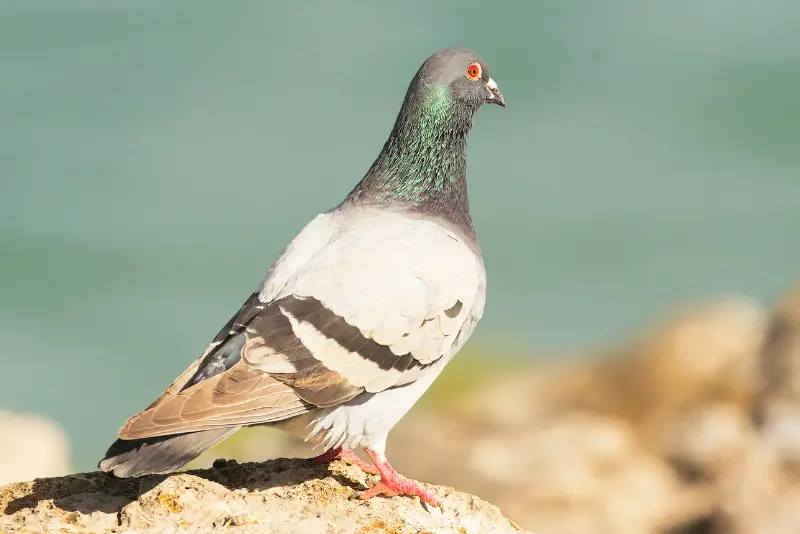
The Rock Pigeon is the most common dove species in the world, as it has adapted extremely well to urban environments, and is found in large numbers in cities all around the globe.
These pigeons are a common sight on many public squares and on the sidewalks of city streets, where they feed on scraps of food that are discarded by humans.
This is another pigeon that isn’t an original native of North America, but was introduced by European settlers in the early 17th Century.
The Rock Dove is considered a pest in many Colorado cities
These pigeons are easily attracted to bird feeders on the ground that offer grains or dried bread. But in many cities Rock Pigeons are considered a pest, and you may not be allowed to feed them.
The increase of Peregrine Falcons breeding in large cities across North America is largely due to the fact that feral Rock Pigeons provide such a rich food source for these raptors in Colorado.
Rock Doves are also famous for their homing abilities, and were used by humans in previous centuries for carrying messages.
Band-tailed Pigeon
Scientific name: Patagioenas fasciata
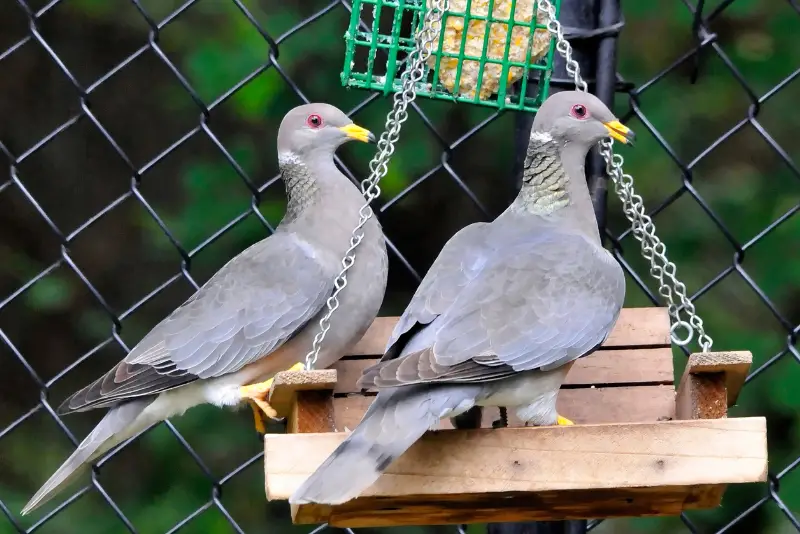
The Band-tailed Pigeon is a bird of the Pacific coast and the Southwestern USA.
While the Band-Tailed Pigeons living along the Pacific coast are found in wet forest habitats, in Colorado these doves nest in dry mountain forests.
It is a summer visitor in Colorado, and migrates south in fall to spend the winter in Central America.
These doves regularly visit bird feeders in Colorado
Band-tailed Pigeons used to be shy forest birds, but have become more and more comfortable around humans, and are now commonly observed visiting platform feeders.
These pigeons are most often found in mature mountain forests, where they forage at the top of tall trees, which makes them difficult to observe.
When flying, they resemble rock pigeons, but can be identified by the pale band at the end of their tail.
Another great distinguishing feature of Band-tailed Pigeons is their partial white neck ring, although juvenile pigeons don’t have this characteristic.
White-winged Dove
Scientific name: Zenaida asiatica
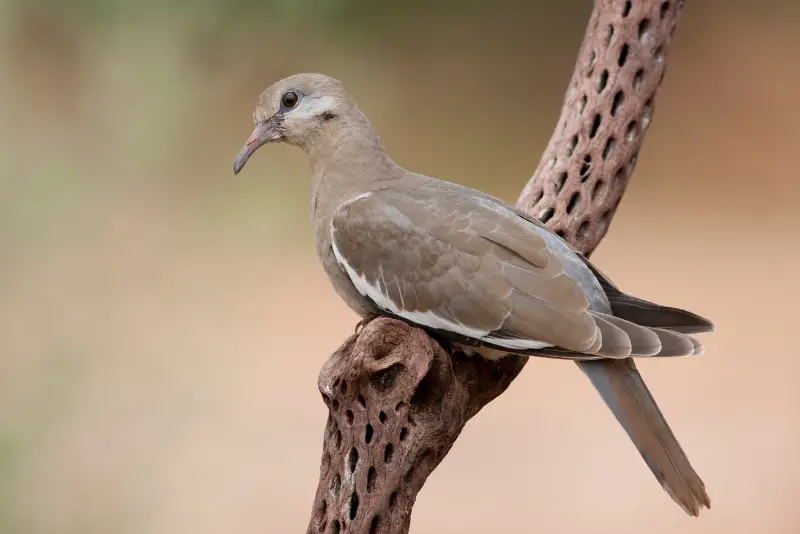
The White-winged Dove used to be a bird of remote desert areas. But as a result of adapting to man-made habitats, it is a summer visitor and breeding bird in cities and towns across the southern US, including southwest Colorado.
Unfortunately, this dove species has become very rare in Colorado during the last two decades, and is now absent from most of the territories that were occupied in the past.
The White-winged Dove is almost entirely light gray, except for a bright white stripe on its wings.
The white areas on the wings are most prominent when it takes to the air, and are a great feature for identifying this species.
It also has a black spot on its cheek, and if viewed close enough, its bright orange eye with a light blue eyering is a great distinguishing feature.
White-winged Doves are frequently found in urban and suburban areas with suitable nesting trees, and are most often encountered foraging on the ground.
During the winter, these doves fly south to spend the cold season in Mexico.
Conclusion
And there we have the doves found in the state of Colorado.
The varied habitats of Colorado are home to more than 400 different species of birds, and doves make up a significant proportion of this rich avifauna.
Including both doves and pigeons, these birds play a vital role in the ecology of their habitats.
If you enjoyed this article, check out our guide to the black birds of Colorado.
